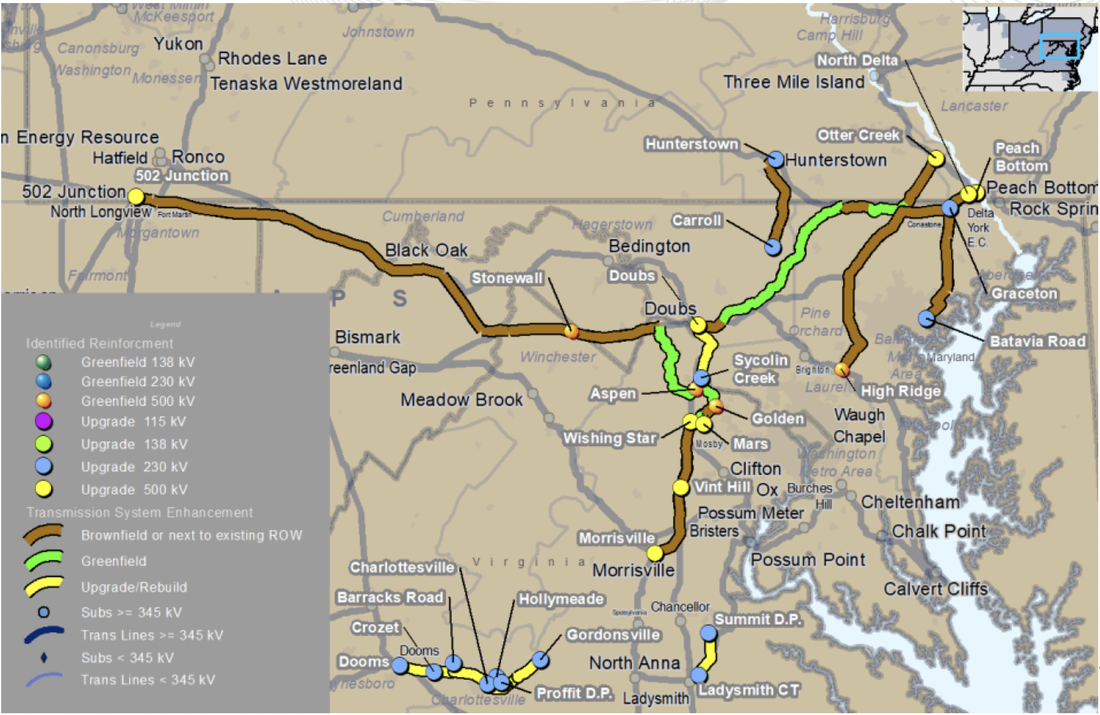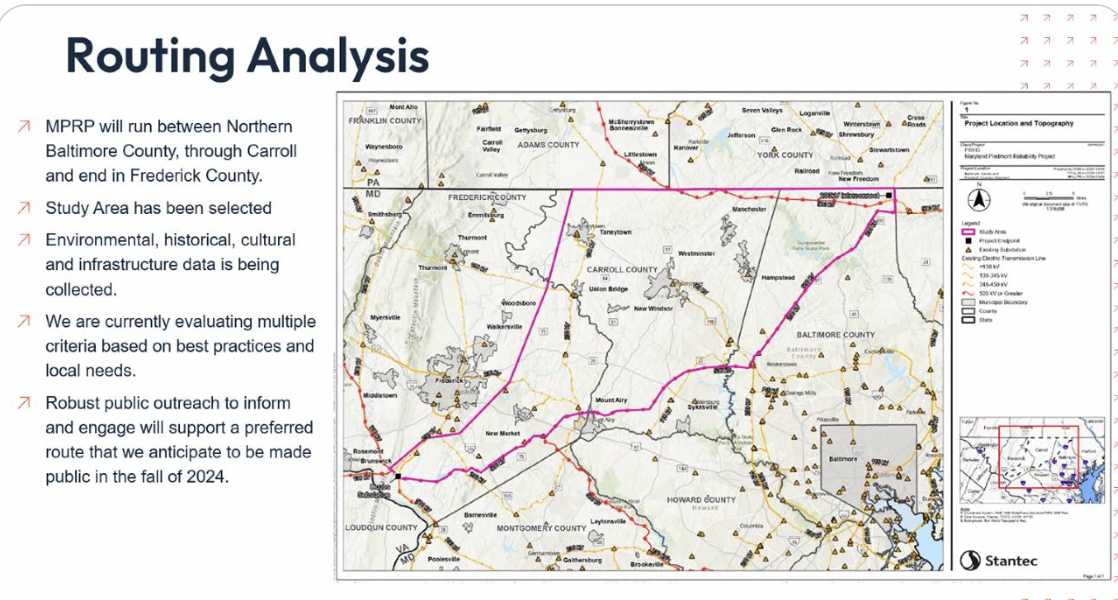In 2023, regional grid manager PJM Interconnection devised a suite of new electric transmission projects designed to import new electricity supplies to new data centers in Northern Virginia, and for Frederick County's new Quantum Loophole project. Data centers use so much electricity, it's equivalent to large cities sprouting up overnight in previously rural places. New cities need new power supplies, especially because Maryland has been closing all its baseload power plants that run on fossil fuels. Before Maryland's recent plant closures under their "clean energy" plan, the state was importing 40% of the energy it used. Now, it needs even more imports! We're heading toward more than 50% of Maryland's electricity being imported from neighboring states via new high-voltage transmission lines. The only two states in the PJM region that generate more electricity than they use and can export to Maryland are West Virginia and Pennsylvania. The MPRP is importing electricity from southeastern Pennsylvania. Other new transmission projects are exporting electricity from West Virginia's coal-fired plants to Loudoun County's "Data Center Alley. It's nothing more than a series of enormous electric extension cords for data centers. In PJM's planning process, it looked like this:
The project was assigned by PJM to New Jersey utility Public Service Enterprise Group. Why them? PJM put its new project requirements out for bid, and PSEG submitted the best project for PJM's needs. PSEG also offered a certain price for the project. There's more to this, but let's stop there for now. Since PJM approved this project and assigned it to PSEG last December, PSEG has been busy devising a route for the project, and now they have finished and want to share it with the public.
PSEG will be holding public "open house" meetings across the project area early next month. See website for details. The "meeting" is hardly an actual meeting though. It's a series of information stations the public is supposed to file through, and you may be handed a card to fill out with your thoughts at the end of the meeting. Each little station will be populated with PSEG representatives, and you can ask them questions. But there is no formal presentation or Q&A session where everyone can hear each question and answer. Go ahead... ask different representatives the exact same question and get wildly different answers. This is why utilities hold these kinds of meetings. They will tell you what they think you want to hear, and not be held accountable for any of it. The main purpose of the "meeting" is to introduce preliminary route maps to the impacted community and receive feedback that could help guide the final route that PSEG files for approval of the Maryland Public Service Commission.
This preliminary route map is floating around social media.
The MPRP will likely need new rights-of-way 150-200 feet wide for its 500kV transmission line. The company will ask landowners to sign easements for a one-time "fair market value" payment for just the land in the easement. This gives PSEG the right to use your land, but you will still own it and pay taxes on it. The easement payments are compensation for land you can no longer use, they are not a windfall or profit.
The MPRP website is chock full of propaganda and small bits of information that impacted landowners need to really investigate. For instance, the website says:
The MPRP is a 500,000-volt (500 kV) transmission line designed to respond to growing electric needs in Maryland and the surrounding region. Transmission reliability is key to supporting Maryland’s energy future.
Here's another:
- Will PSEG want access to my property before I agree to grant an easement for the project?
- PSEG may request prior access to conduct preliminary work such as a survey, delineate wetlands and/or conduct an appraisal to determine the amount of land needed and the value of an easement. In that case, the land owner will be asked to sign a right of entry document allowing PSEG onto the property for only these limited purposes.
I also didn't notice the words "eminent domain" on MPRP's website, but that's exactly how they intend to acquire land from unwilling landowners. Easement offers are nothing more than coercion... sign and take the money... or else. When there's no opportunity to say no, it's not voluntary land acquisition.
PSEG's website, its open house meetings, and its permission forms and easement agreements are written in the company's best interest, not yours!
The best use of PSEG's open house meeting will be the opportunity it gives you to meet new folks who are similarly affected by this project and to exchange contact information and hold further meetings among yourselves to share information of interest to landowners who want to defend themselves against this transmission project. PSEG is not from here, it doesn't know your community, and at the end of the day it doesn't care what happens to it. They can't see it from their house in New Jersey!
It's time to circle the wagons, Frederick County! Later this year, PSEG may file an application with the Maryland Public Service Commission. When that happens, you have the right to intervene and become a party to the case that can submit testimony and cross-examine utility witnesses with the goal of convincing the MPSC to deny a permit for this project. There will also be public hearings held by MPSC where you can speak out against it.
Meanwhile, get engaged and stay current on project news. Talk to your neighbors and others in the community who may be impacted. Make a plan. Maybe I'll see you at the open house...


 RSS Feed
RSS Feed